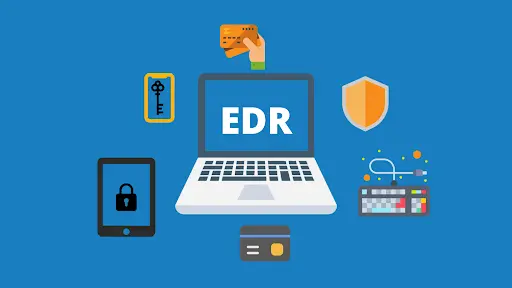EDR Definition: Do you want to protect your organization's endpoints from malicious attacks? It would be best if you relied on Endpoint Detection and Response (EDR) tools. They must have to create robust securitydefense across all endpoints.
More and more organizations are integrating Endpoint detection and response (EDR) into their digital security strategy. According to the Global Market outlook Report, the growth of cloud-based and on-premises Endpoint solutions will be 26 percent annually and will be valued at $7200 million by 2026.
Are you wondering what is an EDR? And how it's going to protect your endpoints. Let's continue reading to learn more about Detection and Response EDR.
What is an EDR Security ?
EDR stands for Endpoint Detection and Response. They are advanced endpoint EDR security software that detects suspicious activity on endpoint devices. It can monitor the activities of endpoints in real-time and analyze data related to potential threats. It will alert the your inhouse cyber administrator when it detects any suspicious activity.
Xcitium's Detection and Response EDR contains the threat and blocks its access so that threat actors can't take over your organization's system. The purpose of this tool is to work as a warning system for suspicious behavior. It allows the security administrator to respond to threat before damage is done.

What is an EDR and What Tools Are Included in EDR
When you explore the market of Detection and Response EDR, you realize that most of them make the most of machine learning capabilities, cyber threat intelligence, and advanced file analysis. As a result, your security team can quickly detect dynamic threats.
As a result, this EDR software offers different features such as:
Malware Detection
Sophos's State of Ransomware report states that almost 66% of organizations will be affected by a ransomware attack in 2021. They increased up to 78 percent in comparison to 2020.
It is vital to stop ransomware attacks on your organization. And it's where Xcitium Detection and Response EDR comes to the rescue. It can block malware and ransomware attacks on your organization by letting your EDR security team detect known and unknown threats.
Application control
Every organization relies on multiple applications across endpoints. There is a need to scan every application thoroughly. A bug on an app offers an easy entry point to threat actors. Your security team can quickly check them and maintain security
Threat Intelligence feed
It can recordand store all the data from endpoint feeds. Your EDR security analyst can look into these feeds and separate malicious activities from normal behavior. Since it also offers event analysis, it's easy to understand the threat context. Your team can pinpoint vulnerable endpoints and prioritize their security more.
File Integrity monitoring
Tons of files are shared all across your business network. You never know what file has a malware injection. Thankfully, an Detection and Response EDR can scan a file and decide whether it is okay to share it across your business system or not.
Host-based intrusion prevention systems (HIPS)
An Detection and Response EDR lets you prevent instruction. Threat actors keep looking for vulnerabilities in your system. They enter and initiate an attack when they find system vulnerability. Usually, threat actors get unauthorized access to employee log-in or ID and use it later to damage the system.
In the presence of an EDR, your system is monitored continuously. As soon as there is an anomaly in behavior, it initiates an alert and lets the cyber administrator start an incident response.
What is an EDR and Know the Benefits of Using EDR Solutions
You know what is an EDR; it's time to get to know its multiple benefits for your organization.
Visibility
Your team can't handle any attack on endpoints unless they know where it happened. Fortunately, they can dig into the threat surface and quickly pinpoint an affected endpoint. In other words, your inhouse team can enjoy great visibility into endpoints. They can see what endpoint is involved and how a threat actor is entered into your system.
Your organization can better monitor suspicious activity through an outstanding level of visibility.
Quick Response
Another plus of a Detection and Response EDR is that it empowers your security team to respond quickly to threats. As soon as an attack happens, your team will get an alert. When you opt for Xcitium EDR, it not only alerts you about the potential threat but also suggests remediation steps. It becomes easy for your team to address an attack effectively.
Reduce the Cost of IT Management
You can replace multiple points solutions with Xcitium's Detection and Response EDR, allowing your organization to manage your endpoint security more efficiently with limited resources. Your security team becomes more efficient as they don't need to invest time in manual security tasks such as vulnerability scans or patch management.
Conclusion - What is an EDR?
Finally, you have a clear picture of a Detection and Response EDR and its different benefits. These EDR security solutions combine multiple security features in one comprehensive package and let you become proactive with your cyber security. It becomes easy for you to detect, monitor and respond to cyber threats.
Do you need the most efficient Detection and Response EDR solution for your business's IT security needs? Consider getting Xcitium EDR. It protects your organization against file-less attacks and APTs.
